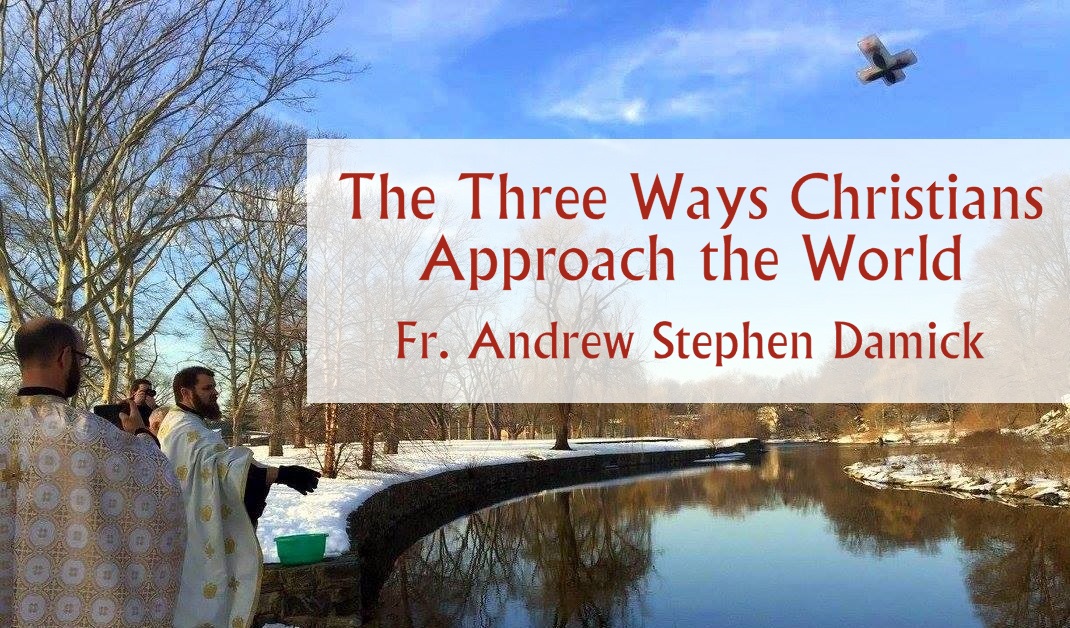
There are generally three approaches that Christians have taken when it comes to their surrounding cultures:
- 1) Rejection, resistance, and hostility: This approach sharply distinguishes the Church from the world, emphasizing that the Church is so much “not of this world” that the world must be fled and an alternate community established. It is a posture that is fully closed to the world — neither in the world nor of the world.
- 2) Accommodation, adaptation, and merger: This approach asks the world what its problems are and then revises Christian faith and practice in order to bring care and comfort to those around the Church. It is a posture that is fully open to the world — both in the world and of the world.
- 3) Engagement, selection, and transfiguration: This approach sees what is good in the world and highlights that, seeking to interpret all things so that all might be pointed to Christ, so that everything might be baptized and transfigured to reveal Christ. It is a posture that has a discerning openness to the world — in the world, but not of the world.
I believe that #3 is the authentic Christian witness, the one witnessed to in the Scripture and the Church Fathers. Both #1 and #2 have truth in them, and what truth they have should not be ignored. But the best of what they have to offer is already in #3, and the worst of what they have to offer is really based in fear — #1 is afraid of the world, and #2 is afraid of the Church.
One of our great difficulties these days is that #3 is invisible to so many Christians. Those burned by #1 say that #2 is the only response. Those alarmed by #2 feel security only in #1.
But Christianity is precisely on a mission to this world, which means that the Church enters the world and brings Christ into it.
The Church does not (#1) stand inside a fortress on a high hill and, like those taunting French knights in “Monty Python and the Holy Grail,” ridicule the world because they’ve already got everything that the world can only hope to attain.
And the Church does not (#2) go into the world and ask how the Church can become more palatable, more accommodating to the world, seeking to do “whatever brings them in,” whatever appears to be the thing that the culture needs.
No, the Church is on a mission (#3), which means entering the world and bringing Christ, engaging with what the world is doing and showing how all creation is meant to point us to Christ, even in its fallen state, even in mankind’s broken and basest desires. Those desires are ultimately for Christ, but they are misdirected into addictions and failures.
If there is anything our Christmas celebrations teach us, it is that this world is not so low or base that God would not Himself become part of it, taking on even its materiality so that God would be revealed.
And if there is anything that our Theophany celebrations teach us, it is that the power of the cross goes forth into creation, that the blessing of the Jordan flows into this world and transforms it.1
And if there is anything that our Pascha celebrations teach us, it is that our Savior and God Jesus Christ will invade even the gates of Hades, that darkest, most Godforsaken place, and shine the light of truth and love even into death itself.
- In traditional Orthodox Christian practice, the service of the Outdoor Blessing of the Waters finds its climax in the throwing of a cross into a body of water. The blessing of water (even indoors) also includes dipping a cross into the water and making the sign of the cross in the water. Theophany is the feast of the Baptism of Jesus.



I admit when reading the three options, #1 appealed to me. The west seems to have become so corrupt, to have lost it’s collective and individual mind, that sometimes I just want to withdraw.
When I read #2 I dismissed it immediately. This sounds like a compromised church that looks no different from the world. It offers a feel-good club on Sunday.
When I read option 3 I felt it was obvious that this is the correct way. Christ, after all, went to the sick and troubled, to seek and save what is lost, as did the apostles. We may be forced to separate and hide soon enough, but until then #3 is the way. And here in the Haliburton Highlands, as far as I know, I’m the only Orthodox believer, though only just baptized. I’ve got my work cut out for me!
Number one is what monastics essentially do. Are you saying they are wrong?
I disagree with your premise, so I can’t answer the question.
The way you describe point #1 is a total caricature. But I course, I wasn’t surprised by that.
Caricature of what?
Caricature of nothing. It was a stupid comment on my part Father. Please forgive.
Sure thing.
I do have certain types in mind, BTW — people like Tertullian, schismatic rigorists, etc. But of course there are more mainstream people who can take this posture, too.
Father Andrew,
Christ is in our midst!
Thank you for the article. Do you believe there is ever a time we will have to reject and resist elements in this world, of course minus the hostility?
For whatever reason, I get the impression that some believe you are misrepresenting the monastic/ascetic calling to reject/resist the world.
May you please speak to this?
In Christ
That’s essentially what I meant by saying that there is some truth in #1. There is a difference between rejecting certain things about the world and rejecting the world. Christ came not to condemn the world but to save it.
I have aspects of #1 and #3, and since, as you say, the good in #1 is already contained in #3, then what I take from #1 would be the negatives. In addition to being afraid of the world (I’m terrified), I would also say there’s also a great deal of anger there, too. Your posts are fabulous, but this one is downright amazing.
Well written, Fr. Andrew. Public Orthodoxy and their ilk are definitely all about option #2.
You are definitely right that people like you and I are called to #3, but the monasteries of Mt. Athos were specifically and consciously designed by their earlier tenants to be “fortresses on a high hill”; and I believe that not only is #1 every bit as viable a choice for us as #3, it may be the most important choice. A gazillion of us acting on #3 might never produce a Mt. Athos. But without Mt. Athos, there would never be any option to perform #3. We need them more than they need us.
Furthermore, we wouldn’t want to carry on the Protestant idea that one is ready to evangelize before one has truly converted and sunk one’s roots in the soil. St. Paul, after all, was impregnably silent and fortified against the world for years before his mission began. #1 — and sometimes a very protracted #1 — always comes before #3, to the best of my knowledge, and that’s just chronologically. It think Orthodoxy teaches that it is prior, principially speaking, as well. You are right that going out into the world is essential, but of the three #1 is the foundation on which going out is built.
I made a pilgrimage to Mount Athos about a year ago, visiting some 12 monastic communities there, and I experienced neither hiding from the world nor hostility to it. They don’t hate and curse the world. They love it. That’s part of why they’re so hospitable and why they pray.
So I’m not sure that you’re reading what I’m saying about #1 correctly.
By the way, just as an interesting data point on the engaging character of Athos, at the first monastery we visited, one of the monks who greeted us rather surprised me by identifying me without my saying anything. It seems that he listens to Ancient Faith Radio podcasts.